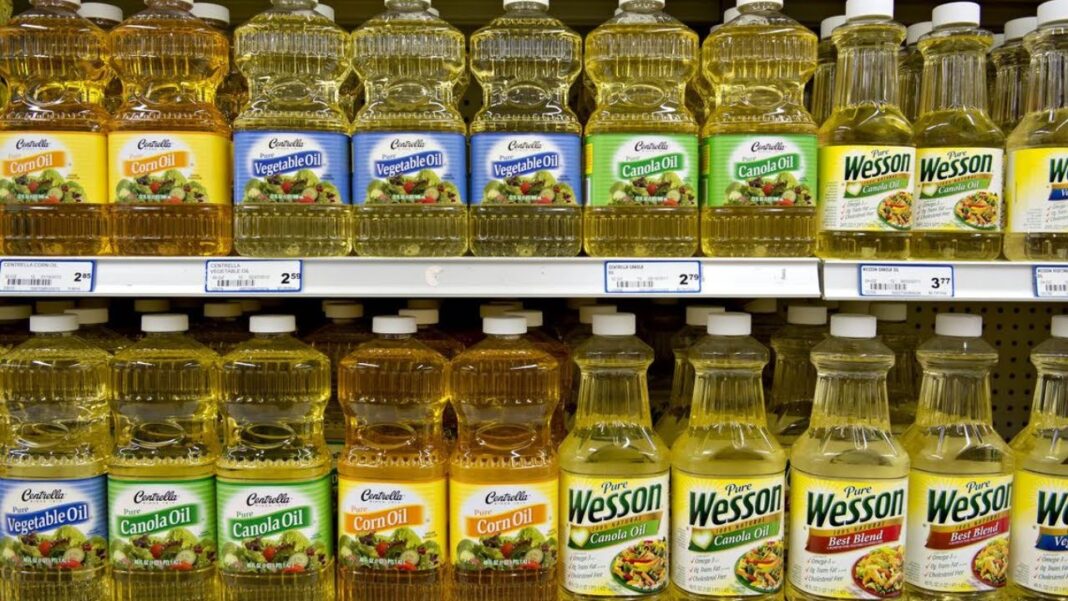Story at-a-glance
- There’s an even worse offender than sugar for your immune system and overall health: industrially processed seed oils, often referred to as “vegetable oils”
- At the root of the harmful biochemical reactions triggered by seed oils is linoleic acid, the primary fatty acid found in polyunsaturated fatty acids (PUFAs)
- The dramatic increase in seed oil intake in recent decades is a key culprit behind the soaring rates of heart disease, cancer, age-related macular degeneration, diabetes, obesity and dementia
- Unsaturated fat intake is associated with increased mortality from COVID-19, while saturated fat intake lowers your risk of death
- Linoleic acid is found in most processed foods, including sauces and salad dressings, along with “healthy” foods like chicken, pork and olive oil
What you eat plays a significant role in how well your immune system functions. As a result, you can actively support your body’s ability to ward off acute and chronic conditions with each food you put into your mouth. However, depending on your food choices, you can also hinder it.
What’s the worst ingredient for your immune system? If you guessed sugar, nice try, but there’s an even worse offender that’s just as prevalent but not as widely recognized for its pernicious influence on health: industrially processed seed oils, often referred to as “vegetable oils.”
At the root of the harmful biochemical reactions triggered by seed oils is linoleic acid, which is an 18-carbon omega-6 fat. Linoleic acid is the primary fatty acid found in polyunsaturated fatty acids (PUFAs) and accounts for about 80% of the fatty acid composition of vegetable oils. Omega-6 fats must be balanced with omega-3 fats in order to not be harmful, but this isn’t the case for most Americans.
Why Seed Oils Are Even Worse Than Sugar
An immunologist with CNBC News recently named sugar the “worst food ingredient for your immune system,” in large part because consuming too much of it can contribute to insulin resistance and obesity, which increases inflammation in your body and causes damage to blood vessels.
While your immune system is busy tending to these areas, CNBC notes, “This creates a major distraction for the immune system and paves the way for dangerous bacteria and viruses to slip through our body’s defenses.” In fact, it’s been known since at least the 1970s that sugar weakens the immune system (while fasting strengthens it), and I recommend limiting added sugars to a maximum of 25 grams per day or 15 grams a day if you’re insulin resistant or diabetic.
But most health “experts” simply do not understand that seed oils are even worse than sugar. These fats become embedded in your cell membranes and stay there for about seven years, wreaking havoc on your health.
Not only are most of the omega-6s you eat, including seed oils, damaged and oxidized through processing, but even if they are unheated and pristine when consumed in any but small amounts, your body degrades them into free radicals that damage virtually every tissue in your body.
“Most of this linoleic acid, when it oxidizes, it develops lipid hydroperoxides and then these rapidly degenerate into … oxidized linoleic acid metabolites,” says Dr. Chris Knobbe, an ophthalmologist and the founder and president of the Cure AMD Foundation.
OXLAMs (oxidized linoleic acid metabolites) create a perfect storm, as they are cytotoxic, genotoxic, mutagenic, carcinogenic, atherogenic and thrombogenic, according to Knobbe. Their atherosclerosis and thrombogenic actions are especially concerning because they can produce strokes and clots, however metabolic dysfunction can also occur.
During the lipid peroxidation cascade caused by the excess consumption of omega-6 seed oils, PUFAs accumulate in your cell membranes, leading to a peroxidation reaction. Because there are so many reactive oxygen species it leads to the development of insulin resistance at the cellular level. OXLAMs are also toxic to the liver and are associated with inflammation, fibrosis and fatty liver disease in humans.5
Dr. Paul Saladino, a physician journalist, also explained in a podcast that linoleic acid “breaks the sensitivity for insulin at the level of your fat cells,” essentially making them more insulin sensitive — and, since your fat cells control the insulin sensitivity of the rest of your body by releasing free fatty acids, you end up with insulin resistance.
Linoleic Acid Drives Chronic Diseases, Worsens COVID-19
There’s virtually nothing more destructive to your body than seed oils in producing heart disease, cancer, age-related macular degeneration, diabetes, obesity and dementia. When I interviewed Tucker Goodrich, who developed an IT risk management system used by two of the largest hedge funds in the world, then transitioned into medical research, he explained that animals typically develop cancer once the linoleic acid in their diet reaches 4% to 10% of their energy intake.
Yet, most Americans get approximately 8% of their calories from seed oils. “So, we’re way over what these thresholds in the lab would suggest is a safe level of these fats based on the laboratory work in animals,” Goodrich said, adding:
“We’ve got this huge disconnect between what the lab science tells us we should be doing and what our dietary guidelines tell us we should be doing. The scientists are saying, ‘Oh, look, it’s poison. It causes all the chronic diseases,’ and the government’s saying, ‘Eat lots of it.’ That’s not a good thing.”
Data also indicate that COVID-19 mortality rates are heavily influenced by the amount of unsaturated fats you eat. Simply put, unsaturated fat intake is associated with increased mortality from COVID-19, while saturated fat intake lowers your risk of death. The authors noted that unsaturated fats “cause injury [and] organ failure resembling COVID-19.”
More specifically, unsaturated fats are known to trigger lipotoxic acute pancreatitis, and the sepsis and multisystem organ failure seen in severe cases of COVID-19 greatly resembles this condition. In short, linoleic acid contributes to the inflammatory domino effect that eventually kills some people with COVID-19. Goodrich explained:
“I did an enormous post on this, looking at the effects of LA [linoleic acid] in SARS COV-2 and SARS in general. SARS is a severe acute respiratory syndrome. SARS kills you by giving you acute respiratory distress syndrome (ARDS).
ARDS can be caused by lots of different things, not just these viruses. You can get it from influenza. You can get it from inhaling acid into your lungs. What’s fascinating is the human literature is quite clear that you can induce ARDS through feeding seed oils.
Very sick people who can’t eat are fed intravenously. It’s called total parenteral nutrition (TPN). Generally, this is used through a product called Intralipid, which is made out of soybean oil and sugar. When you start to understand all this stuff, it’s just mind boggling. Doctors did an experiment after they noticed that a lot of their patients who came into the ICU and got TPN then subsequently got ARDS.
So, they started playing with what they were feeding them, and what they discovered was this soybean oil formula increased the patient’s rate of getting ARDS. The fatality rate from ARDS is 30% to 60%. Feeding seed oils increased the rate of ARDS by seven times.”
It’s Hidden in ‘Healthy’ Foods, Like Chicken and Olive Oil
Another reason why linoleic acid is so harmful is because it’s found in virtually every processed food, including restaurant foods, sauces and salad dressings. Many processed foods high in sugar also contain seed oils, which is why eliminating them from your diet is essential for improving and maintaining your health.
However, even if you cut out processed foods and skip sauces and salad dressings when you eat out, you may still be consuming too much seed oil because it’s hidden in “healthy” foods like chicken and pork. The problem is that these animals are fed grains that are high in linoleic acid, which makes the meat a major source as well. So if you’re eating chicken and pork, believing it to be good for you, you’re being misled.
Olive oil is another health food that’s a hidden source of linoleic acid; however, there are caveats. As Goodrich explained, the linoleic acid content of olive oil can vary significantly. “The percentages that I’ve seen quoted in literature range from 2%, which is awesome, to 22%, which is not good,” he said.
Olive oil also has the benefit of containing beneficial oleic acid, which is protective against both cardiolipin oxidation and LDL oxidation. Cardiolipin is a type of fat located in your mitochondria, and oxidation of cardiolipin is one of the things that controls autophagy.
By altering the composition of cardiolipin in your mitochondria to one that’s richer in omega-6 fats, you make it far more susceptible to oxidative damage. Goodrich cites research showing that when the linoleic acid in cardiolipin is replaced with oleic acid like that found in olive oil, the cardiolipin molecules become highly resistant to oxidative damage.
The other variable, however, is that olive oil is often cut with cheaper seed oils, which raises the linoleic acid content. So if you consume olive oil, I strongly recommend keeping close track of your total linoleic acid intake.
How Much Linoleic Acid Is Too Much?
Many now understand that your omega-6 to omega-3 ratio is very important, and should be about 1-to-1 or possibly up to 4-to-1, but simply increasing your omega-3 intake won’t counteract the damage done by excessive linoleic acid. You really need to minimize the omega-6 to prevent damage from taking place.
Ideally, consider cutting linoleic acid down to 2 or 3 grams per day, which is close to what our ancestors used to get before all of these chronic health conditions, including obesity, diabetes, heart disease and cancer, became widespread. If olive oil puts you over the limit, consider cooking with tallow or lard instead. Beef tallow is 46% oleic acid and lard is 36% oleic acid.
Remember, linoleic acid is considered an essential fat, so you don’t want to eliminate it entirely. It’s only when consumed in excessive amounts that linoleic acid acts as a metabolic poison — but virtually everyone is consuming excessive amounts.
What amount is “excessive”? Anything over 10 grams a day is likely to be problematic, although the exact cutoff is still unknown. In 1909, Americans ate 2 grams a day of vegetable oil, according to Knobbe, but by 2010 this had increased to 80 grams a day.10
If you’re not sure how much you’re eating, enter your food intake into Cronometer — a free online nutrition tracker — and it will provide you with your total linoleic acid intake. The key to accurate entry is to carefully weigh your food with a digital kitchen scale so you can enter the weight of your food to the nearest gram.
Cronometer will tell you how much omega-6 you’re getting from your food down to the 10th of a gram, and you can assume 90% of that is linoleic acid. Again, anything over 10 grams is likely to cause problems. Since there’s no downside to limiting your linoleic acid, you’ll want to keep it as low as possible, which you do by avoiding high-LA foods. This means eliminating all of the following oils:
Other high-LA foods include chips fried in vegetable oil, commercial salad dressings and sauces, virtually all processed foods and any fried fast food, such as french fries. I’m currently writing a book on this topic as well, so stay tuned for more information about what I believe is likely the leading contributing cause of virtually all chronic diseases we’ve encountered over the last century.
References
- CNBC January 15, 2022
- The American Journal of Clinical Nutrition, Volume 26, Issue 11, November 1973, Pages 1180–1184
- YouTube June 13, 2020
- J Lipid Res. 2018 Sep; 59(9): 1597–1609
- YouTube June 23, 2020
- YouTube, Omega-6 Apocalypse 2, Chris Knobbe August 25, 2021
- Gastroenterology 2020 Sep; 159(3): 1015–1018.e4
- Journal of Dairy Science January 2018; 101(1): 222-232









